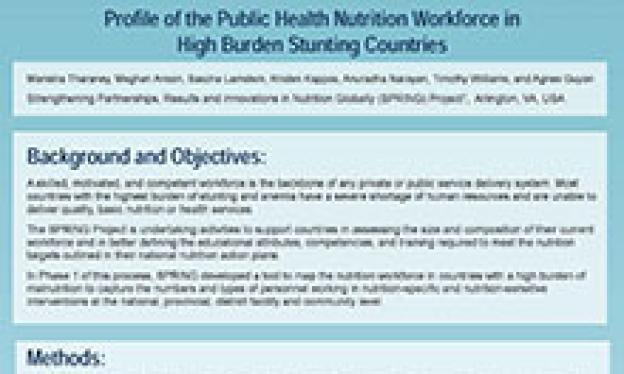Authors: Tharaney M; Anson M; Lamstein S; Kappos K; Narayan A; Williams,T; Guyon, A
Background and objectives: A skilled, motivated, and competent workforce is the backbone of any private or public service delivery system. Most countries with the highest burden of stunting and anemia have a severe shortage of human resources and are unable to deliver quality, basic nutrition or health services. The SPRING Project is undertaking activities to support countries in assessing the size and composition of their current workforce and in better defining the educational attributes, competencies, and training required to meet the nutrition targets outlined in their national nutrition action plans. In Phase 1 of this process, SPRING developed a tool to map the nutrition workforce in countries with a high burden of malnutrition to capture the numbers and types of personnel working in nutrition-specific and nutrition-sensitive interventions at the national, provincial, district facility and community level.
Methods: To develop SPRING’s Nutrition Workforce Mapping Tool, national nutrition action plans and strategies were scanned to identify prioritized nutrition-specific and nutrition-sensitive interventions. These interventions were matched with the high-impact interventions outlined in the Lancet Series on Maternal and Child Undernutrition (2008 & 2013) and the World Health Organization’s Essential Nutrition Actions: improving maternal, newborn and infant and young child health and nutrition (2013). A matrix of the high-impact interventions and the range of providers offering these services at the facility, community, regional, and national levels was created using Microsoft Excel software. This matrix will be populated at both the national and district level in countries where the tool is applied. In addition to the profile of workers, the tool also identifies the total number of workers in a district and the proportion of those workers engaged directly in implementing nutrition activities.
Results: A draft tool has been developed that will be field tested in select countries.
Conclusions: SPRING’s Nutrition Workforce Mapping Tool is designed to be an efficient tool to map and summarize the various cadres of workers engaged in providing nutrition services at the country level, as well as the potential of engaging additional workers to address nutrition in their job. The mapping tool can be used as both a planning and advocacy tool, as it provides a comprehensive picture of the workforce engaged in nutrition interventions while also informing policymakers of programming and resource allocation decisions around human resources. In addition, the tool encourages the translation of nutrition policy into measurable objectives, the development of detailed plans by quantifying the numbers of skilled, highly competent workers needed to serve communities with diverse nutrition needs.
